Argyle Street Waterworks Depot
The Argyle Street Waterworks Depot (Chinese: 水務署亞皆老街廠) was a building of the Water Supplies Department located in Mong Kok, Yau Tsim Mong District, Hong Kong.
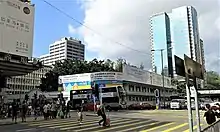
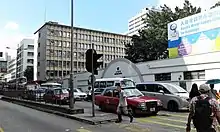
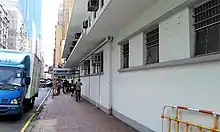
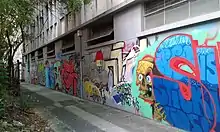
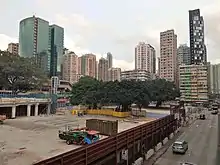
Location
The Argyle Street Waterworks Depot was located in Mong Kok, at the intersection of Argyle Street and Sai Yee Street, at No. 111 Argyle Street and No. 128 Sai Yee Street, near Mong Kok East station.[1]
History
The Argyle Street Waterworks Depot was built in 1950.[2] An additional three storey block of offices was completed in 1954.[3] One morning during the 1967 Hong Kong riots, 300 workers at the Argyle Street Waterworks Depot left their work at 9 am in a protest against the move to suspend 12 fellow workers.[4]
The building housed the New Territories West (NTW) Regional Office of the Water Supplies Department. It was a depot-type office for the operation and maintenance staff and vehicles of the Water Supplies Department and its contractors. It served the "NTW region", covering Tsuen Wan, Kwai Chung, Tsing Yi, Yuen Long, Tuen Mun and Tin Shui Wai. The building also housed a small Water Resources Education Centre since the early 2010s.[5]
The building was demolished in 2019.[2] The WSD Mong Kok Office was relocated to WSD Tin Shui Wai Building at 20 Tin Pak Road, Tin Shui Wai.[6]
Features
The building was built in Modernist style.[2]
A section of the "Mongkok's Graffiti Wall of Fame" was painted on north eastern side of the building.[7]
Future
The demolition site is managed by the Architectural Services Department. Two banyans that are around 50 to 70 years old, remain on the site.[8][9] The redeveloped site also includes the area of the former FEHD Sai Yee Street Environmental Hygiene Offices-cum-vehicle Depot.[10] The site is expected to be later sold for office and commercial development.[11]
References
- "Plight of banyan trees is a blot on Hong Kong". South China Morning Post. 10 June 2019.
- "永別,近70年旺角水務署". thestandnews.com (in Chinese). 10 January 2019.
- Hong Kong Public Works Department (1954). Hong Kong Annual Departmental Work Report by the Director of Public Works for the Financial year 1954-55. Government Printer. p. 65. ASIN B009M72TM4. OCLC 654640401.
- Cooper, John (1970). Colony in Conflict: The Hong Kong Disturbances, May 1967-January 1968. Swindon Book Company. p. 38.
During the same morning, trouble had also come to another Government Depot in the Colony when 300 workers at the Argyle Street Waterworks Depot left their work at 9 a.m. in a protest against the move to suspend 12 fellow workers. Fortunately, water supplies were not affected.
- "Background brief on the relocation of New Territories West Regional Office and Water Resources Education Centre of Water Supplies Department to Tin Shui Wai" (PDF). Legislative Council of Hong Kong. 24 March 2015.
- "Relocation Notice of Water Supplies Department New Territories West Regional Office". Water Supplies Department. Retrieved 7 June 2020.
- "Mongkok's Graffiti Wall of Fame!". Hong Kong Hustle. 3 July 2013.
- Zhang, Karen (2 June 2019). "Condition of two heritage banyans in Mong Kok reflect Hong Kong's troubles with tree management". South China Morning Post.
- Zhang, Karen (7 June 2019). "Tree experts want better protection for two symbols of Hong Kong's heritage as demolition work threatens banyans". South China Morning Post.
- "Planning and Design Study on the Redevelopment of Government Sites at Sai Yee Street - Feasibility Study" (PDF). Arup. 6 June 2018.
- 梁敏德 (13 July 2018). "旺角水務署擬重建改劃 區議員轟社區設施變摩天大廈". inmediahk.net (in Chinese).
External links
| Wikimedia Commons has media related to Argyle Street Waterworks Depot. |
- "「天水圍的日與夜」前傳 - 那一年,你在旺角廠做了甚麼?" (PDF). Droplet (in Chinese). Water Supplies Department. July 2018. pp. 4–15.
- "Planning and Design Study on the Redevelopment of Government Sites at Sai Yee Street and Mong Kok East Station - Feasibility Study" (PDF). Town Planning Board. 1 April 2016.